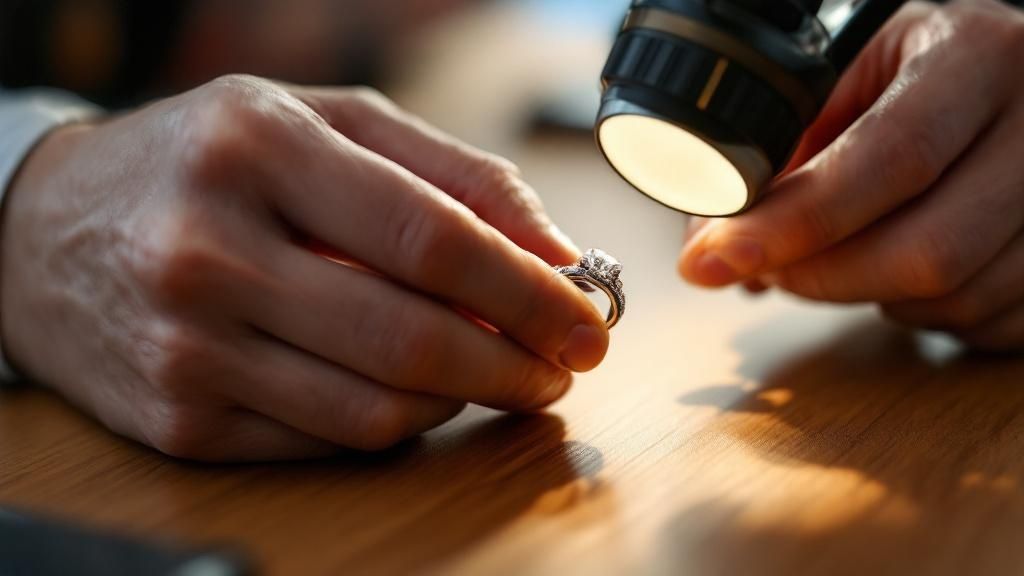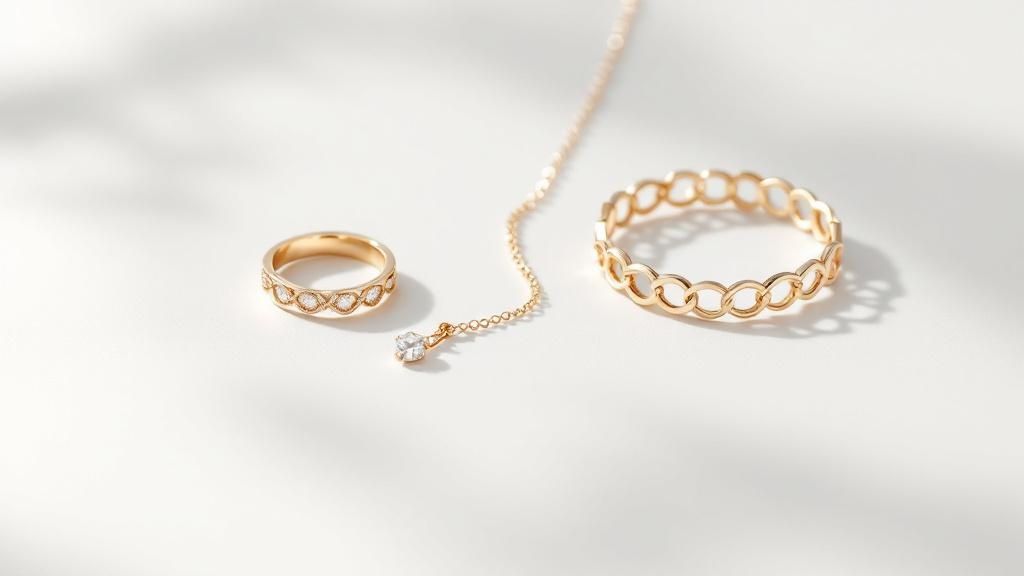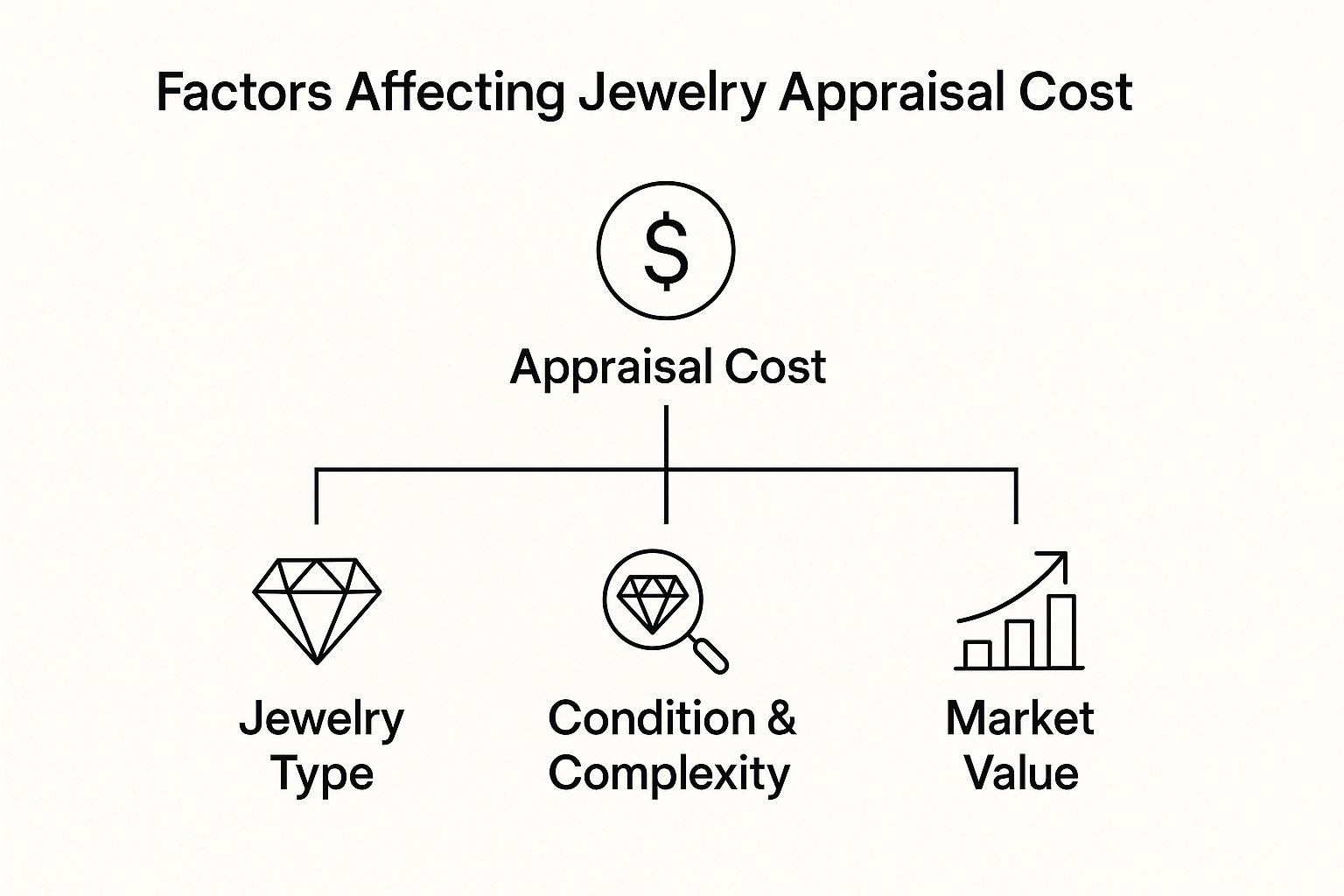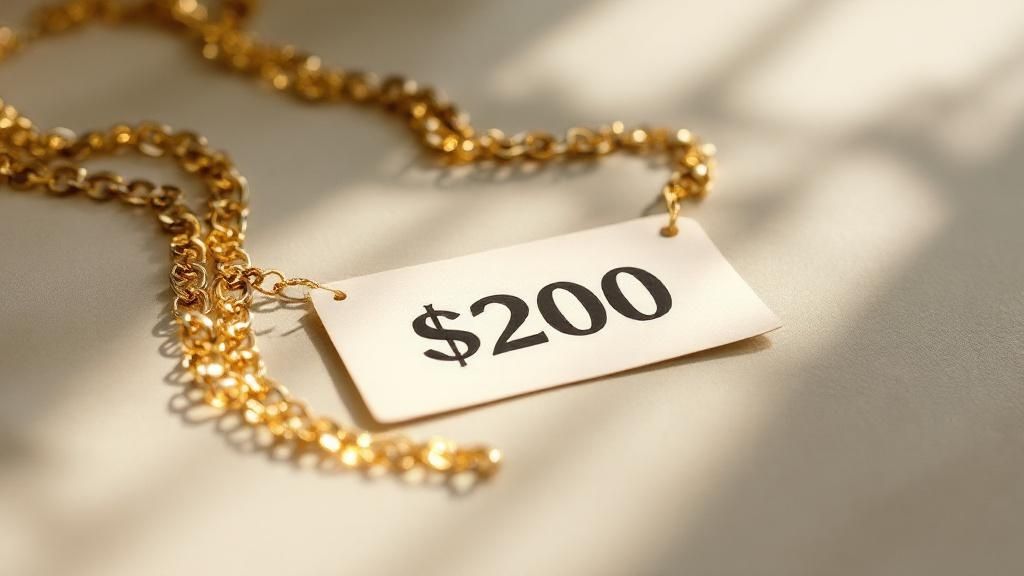How Much for Jewelry Appraisal? A Complete Cost Guide
- alex mark
- Jul 12
- 14 min read
When you start thinking about getting your jewelry appraised, one of the first questions that comes to mind is, "What's this going to cost me?" Generally, you can expect to pay anywhere from $75 to $350 per piece for a professional appraisal. But that's just a ballpark figure.
The final price really comes down to how the appraiser structures their fees. Some charge by the hour, others have a set price per item, and some offer a flat rate for an entire collection. It’s a lot like hiring any other skilled professional, whether it's a plumber or a lawyer—you’re paying for their dedicated time, specialized tools, and years of hard-earned expertise.
Jewelry Appraisal Costs: A Quick Overview

It’s easy to just focus on the final dollar amount, but a smarter approach is to understand how an appraiser arrives at that number. Getting familiar with the different pricing models gives you more control and helps you find the right expert for your specific needs.
Think of it this way: a mechanic might have a standard charge for a simple oil change, but they'll switch to an hourly rate for a tricky engine diagnostic. Jewelry appraisal works the same way. A modern, straightforward wedding band is a relatively quick job. An antique Art Deco brooch with multiple gemstones and a murky history? That’s going to take a lot more research and time.
Comparing Common Fee Structures
To give you a clearer picture of what to expect, let's look at the most common ways appraisers charge for their work. Each model has its own advantages, depending on what you're bringing in. Knowing the difference can save you from surprises and ensure you're paying a fair price for a thorough, professional valuation.
A Word of Warning: A trustworthy appraiser will never charge a fee based on a percentage of your jewelry's final value. This is a massive ethical red flag. It creates a clear incentive for them to inflate the price, which doesn't serve you at all. Stick with professionals who offer a flat fee or an hourly rate.
To help you compare, here's a table breaking down the typical fee structures you'll run into. This quick guide can help you figure out which pricing model makes the most sense for your situation.
Common Jewelry Appraisal Fee Structures
This table compares how appraisers charge for their services, helping you understand which model might apply to your jewelry.
Fee Structure | Typical Cost Range | Best For |
|---|---|---|
Per-Item Fee | $75 - $150 per piece | One or two straightforward items, like a single diamond ring, a gold chain, or a pair of earrings. |
Hourly Rate | $150 - $350 per hour | Complex, antique, or highly detailed pieces that demand in-depth research and meticulous examination. |
Flat Rate | Varies (often discounted) | Large collections of jewelry, such as an entire estate or multiple inherited pieces from family. |
So, what does this all mean for you?
Ultimately, finding the right appraiser is about matching your jewelry to their pricing model. If you've got a whole drawer full of family heirlooms to sort through, finding someone who offers a flat-rate package for the entire collection will almost certainly be more economical than paying for each piece individually.
What an Appraisal Fee Actually Covers

When you get a quote for a jewelry appraisal, it's natural to ask, "What am I really paying for here?" It's a fair question. The fee isn't just for a final number on a fancy piece of paper; it’s an investment in a highly detailed, professional service performed by a skilled expert.
Think of it less like a price tag and more like a comprehensive home inspection, but for your most cherished valuables. You're paying for the appraiser's years of training, their access to specialized gemological equipment, and the time they spend conducting meticulous market research behind the scenes.
Breaking Down the Appraiser's Process
So, what exactly happens after you hand over your jewelry? The fee covers an intricate, multi-step process where every single detail is put under the microscope. This is far from a quick glance—it's more like a forensic examination of the piece's identity and history.
An appraiser undertakes several critical tasks, each demanding a specific skill set and often some pretty expensive tools. The core of their work includes:
Gemstone Identification: Figuring out what every stone is, telling the difference between natural gems and lab-created synthetics, and spotting any treatments or enhancements.
Diamond Grading: Meticulously grading each diamond according to the 4Cs—carat weight, color, clarity, and cut. These are the universal standards that determine a diamond's quality and value.
Metal Purity Testing: Using non-destructive methods to confirm the type and purity of the precious metal, whether it's 14K or 18K gold, platinum, or something else.
Evaluating Craftsmanship: Looking at the overall quality of how the piece was made, the complexity of its design, and its current condition.
The true value of an appraisal isn't just the final price—it's the comprehensive, legally sound document that backs it up. This report is what you need to get proper insurance coverage, handle estate planning, or set a fair price if you ever decide to sell.
Research, Valuation, and Final Reporting
Once the hands-on inspection is done, another crucial phase of the work begins. The appraiser has to dive deep into market research to land on an accurate and justifiable value. This involves digging through current sales data for items that are truly comparable to yours. It's this step that really helps answer the question of how much for jewelry appraisal is fair in today's market.
This is where an appraiser's experience becomes invaluable. They know exactly where to look to find the right market for your specific item, whether it's a brand-new designer piece or a rare antique from a bygone era. This detailed work ensures the valuation is defensible and reflects a true replacement or fair market value. In fact, the demand for certified appraisals is a major force behind the global jewelry appraisal market, which is on track to hit about $3.79 billion by 2025. You can learn more about this market growth to see just how significant this industry is.
Finally, all of this information—the detailed descriptions, precise measurements, quality grades, photographs, and researched value—is compiled into a formal, written report. This document is your official proof of value, and the expertise, time, and care it takes to create it is what your appraisal fee truly covers.
Key Factors That Influence Appraisal Costs
Ever wondered why one jewelry appraisal might cost $75 while another is over $300? It's not just a random number. The price you pay for a professional appraisal is a direct reflection of the time, expertise, and deep-dive research needed to accurately value your piece.
Think of it like hiring a skilled tradesperson. A simple, straightforward job has a predictable cost. But when you need someone to diagnose a complex, hidden problem that requires specialized tools and hours of investigation, the price goes up. Valuing jewelry works the same way.
Let's break down the core elements that shape the final cost.

As you can see, it really boils down to the jewelry’s unique characteristics, its complexity, and the purpose of the appraisal itself.
Item Complexity and Number of Pieces
The single biggest factor driving the cost is how complex the jewelry is. A simple, modern solitaire diamond ring is fairly easy to assess. An antique Edwardian necklace with multiple types of gemstones, delicate filigree, and a hard-to-identify maker's mark? That’s a whole different story.
Here’s what really adds to the workload and, by extension, the price tag:
Multiple Gemstones: Every single stone has to be identified, measured, graded for quality, and checked for any treatments. Appraising a piece with ten small diamonds is much more time-consuming than one with a single large diamond.
Intricate Designs: A highly detailed piece from a specific era, like Art Deco or Victorian, requires more research to confirm its authenticity and the quality of its craftsmanship.
Antique or Vintage Status: Older items demand specialized knowledge. The appraiser needs to identify period-specific manufacturing techniques and properly assess the piece's condition relative to its age.
It also stands to reason that the more items you have, the higher the total bill will be. However, many appraisers offer a better rate for larger collections, so you often get a discount compared to paying the full per-piece price for each one.
Appraiser Credentials and Geographic Location
Not all appraisers are created equal. Their training, experience, and professional credentials have a direct impact on their fees, and for good reason. An appraiser with top-tier qualifications has invested a small fortune in their education, tools, and continuing education.
An appraiser with a Graduate Gemologist (GG) diploma from the Gemological Institute of America (GIA) or a certification from the American Society of Appraisers (ASA) is at the top of their field. You're paying more for their expertise, but that fee buys you a higher level of certainty and accuracy.
Where you live also matters. Just like most professional services, appraisal fees in major cities with a high cost of living (think New York or Los Angeles) are generally higher than in a smaller town. Knowing these value drivers is also helpful when you're trying to determine if jewelry is a good investment, as they are tied to its long-term worth.
The Purpose of the Appraisal
Finally, why you need the appraisal plays a huge role. The purpose dictates the type of research required and how the final report is formatted, which in turn affects the cost.
For instance, an appraisal for insurance replacement is meant to determine the full retail cost to buy a brand new, comparable item from a store today.
An estate appraisal, on the other hand, calculates the fair market value—the price a willing buyer would likely pay a willing seller. These are two very different values that require distinct approaches, directly influencing the appraiser's time and the final fee.
How Appraisal Types Affect The Price

One of the biggest things that will move the needle on cost is the reason you need the appraisal in the first place. Not all valuations are created equal. The "why" behind your request directly shapes the appraiser's entire process—from the research they conduct to the final value they land on.
Asking "how much for a jewelry appraisal?" without specifying the type is a bit like asking a mechanic for a repair quote without telling them what’s wrong with your car. Is it just a simple oil change, or do you need a full engine rebuild? The answer changes everything.
Different situations call for different kinds of value. A professional appraiser has to aim for the right market and use the correct valuation method to give you a document that's actually useful and legally sound. This work directly influences the time and expertise required, which, you guessed it, determines the final price you'll pay.
The Big Three Appraisal Types
Most requests for appraisals will land in one of three main buckets. Each one serves a very different purpose, and believe it or not, each will produce a different dollar value for the exact same piece of jewelry. Knowing the difference is crucial for getting what you need and paying a fair price for it.
Insurance Appraisals: This is by far the most common request. The goal here is to figure out the full Retail Replacement Value. In plain English, that’s what it would cost to walk into a retail store today and buy a brand-new, nearly identical item. This figure is almost always the highest because it has to account for retail markups, labor, and current market prices for gems and metals.
Estate Appraisals: When settling an estate for probate or tax reasons, you need an appraisal that establishes Fair Market Value (FMV). This is the price that a piece would likely sell for between a knowledgeable buyer and seller who aren't in a rush or under pressure. It reflects a more realistic secondary market price, so it's typically lower than the insurance value.
Resale or Liquidation Appraisals: This appraisal answers the question, "What could I get for this if I needed to sell it now?" Often called the Orderly Liquidation Value, this is what a jeweler, pawnshop, or other dealer would realistically pay you for the item. As you can imagine, this is usually the lowest value of the three.
Here's the most important thing to remember: The insurance value is based on the cost to replace something at retail. Estate and resale values are based on what it would likely sell for in a completely different market. That's the whole ballgame.
This fundamental difference is why insurance appraisals often cost a bit more. They require the appraiser to do their homework on current, up-to-the-minute retail pricing, which can be more time-consuming.
Comparing The Main Types of Jewelry Appraisals
To help you choose the right service for your situation, it's helpful to see the main appraisal types side-by-side. Understanding their core purpose and how they arrive at a value will ensure you're asking for—and paying for—exactly what you need.
Appraisal Type | Primary Purpose | Valuation Method | Relative Cost |
|---|---|---|---|
Insurance | To obtain coverage against loss, theft, or damage. | Full Retail Replacement Value | Higher |
Estate | To settle an estate and calculate inheritance taxes. | Fair Market Value (FMV) | Moderate |
Resale | To determine a realistic selling price in a quick sale. | Orderly Liquidation Value | Moderate |
Getting the right appraisal from the start saves you time, money, and future headaches. For example, trying to sell a ring using its high insurance value will probably lead to disappointment. On the flip side, using a low liquidation value to get insurance could leave you seriously under-covered if something happens to your piece.
So, before you hand over your jewelry, be crystal clear with your appraiser about why you need the valuation. It makes all the difference.
How To Find A Reputable Appraiser
Knowing how much an appraisal will cost is one thing, but that number is only useful if the valuation is accurate and unbiased. Honestly, finding a trustworthy and qualified professional is the most critical part of this whole process. A great appraiser gives you more than just a number on a piece of paper; they give you peace of mind.
Think about it like choosing a surgeon for a specialized procedure. You wouldn't just pick a name out of a hat; you'd meticulously check their credentials, experience, and reputation. The same principle applies here. The quality of your appraisal document—the very thing you need for insurance or settling an estate—hinges entirely on the expertise and integrity of the person who writes it.
Verify Their Credentials and Affiliations
The first thing you should do when vetting an appraiser is look for proof of their formal training and professional affiliations. Legitimate experts are proud of their qualifications and will have them on full display. Don't ever feel shy about asking to see them.
You're looking for certifications from highly respected industry organizations. These groups have stringent educational requirements, strict ethical codes, and usually require ongoing education to keep a member in good standing.
The most recognized credentials in the business include:
GIA (Gemological Institute of America): A Graduate Gemologist (GG) diploma is the gold standard. It means the appraiser has a deep, comprehensive knowledge of gemstones.
ASA (American Society of Appraisers): An Accredited Senior Appraiser (ASA) designation shows proven expertise in valuation theory and appraisal practices.
ISA (International Society of Appraisers): A Certified Appraiser of Personal Property (CAPP) designation signals extensive training in appraisal methodology and ethics.
An appraiser’s credentials are a direct reflection of their commitment to their profession. This isn't just about passing tests; it’s about adhering to a high ethical standard that protects you, the consumer.
Spotting Red Flags and Common Scams
Knowing what to look for is just as important as knowing what to avoid. A few clear warning signs can help you steer clear of unqualified or outright unethical appraisers.
The biggest red flag? An appraiser who wants to charge a fee based on a percentage of the jewelry's final value. This creates a massive conflict of interest, giving them a financial incentive to inflate the value of your piece. A professional should always charge a flat hourly rate or a per-item fee.
Another sign of trouble is an appraiser who immediately pressures you to sell your item to them or one of their partners right after the appraisal. A professional's job is to give you an objective valuation, not to double as a broker. This dual role completely compromises their neutrality. In fact, growing consumer demand for this kind of transparency is a key reason the global jewelry appraisal market is expected to grow by $2.07 billion between 2024 and 2029. You can learn more about the drivers of this market growth if you're interested.
Independent Appraiser vs. In-House Jeweler
Finally, you'll need to decide between using an independent appraiser and the in-house appraiser at a retail jewelry store. While many store appraisers are perfectly skilled, an independent professional who doesn't buy or sell jewelry has absolutely no vested interest in the outcome.
Their entire business is built on providing accurate, objective valuations. This guarantees a higher level of impartiality, which is especially critical for high-value items where an unbiased report is non-negotiable. After all, this document is what you'll use to protect your asset. For more on this, check out our guide on how to insure jewelry the right way.
What To Expect During Your Appraisal
Walking into a jewelry appraisal can feel a bit like stepping into the unknown, especially your first time. Let’s pull back the curtain on the process. Knowing what happens step-by-step will help you feel prepared and confident, not intimidated. It's best to think of it as a collaboration—you and a professional working together to uncover and document your jewelry's unique story and value.
This isn't just a quick glance. It's a meticulous, in-depth examination. Coming prepared will make a world of difference in the accuracy of the final report.
The Initial Examination and What To Bring
Your appointment will kick off with a thorough, hands-on inspection of your piece. The appraiser will usually do this right in front of you, carefully measuring dimensions, testing the metals, and identifying every single gemstone. They’ll also note any special markings or hallmarks, evaluate the quality of the craftsmanship, and take detailed photographs from every angle.
To give your appraiser the best possible head start, it's a huge help if you can bring along any paperwork you have.
Previous Appraisal Reports: These create a historical record for the piece.
Original Sales Receipts: These can help establish provenance (the item's history) and its original cost.
Diamond or Gemstone Certificates: Reports from labs like GIA are essential for confirming a stone's grades.
Being organized not only makes the process smoother and faster but also contributes to a more precise valuation. The more information you can provide upfront, the more robust the final report will be.
Feel free to ask questions during the appointment! A great appraiser will be more than happy to walk you through what they're looking for, explain the tools they're using, and clarify why certain characteristics are so important in determining the final value.
From Inspection to Final Report
Once the physical examination is complete, the appraiser’s real detective work begins. They take all the data they've collected from your jewelry and dive into research, cross-referencing it with current market trends and sales data to assign a value. This behind-the-scenes effort is where their deep expertise really comes into play.
There’s a reason this hands-on, expert-driven approach is still so vital. In fact, the market for in-person jewelry appraisals is projected to grow to around $3.4 billion by 2030. You can read the full research about this market trend to see why this personal touch remains so crucial.
Finally, you’ll be given a detailed written report. This is the official document you'll need for insurance coverage, estate planning, or any other formal purpose. One last tip: before your appointment, it’s always a good idea to make sure your pieces are clean and looking their best; our guide has some excellent jewelry care tips to keep your pieces sparkling.
Common Questions About Appraisal Costs
Even after you've got the basics down, you'll probably still have a few questions about getting your jewelry appraised. It's completely normal. Let's tackle some of the most common things people ask when trying to figure out what a fair price for an appraisal really is.
Why Did My Appraisal Value Seem Low?
This is a big one, and it almost always comes down to the purpose of the appraisal. If a valuation feels lower than you expected, it was likely done for resale or estate purposes. These appraisals determine fair market value—what a piece would realistically sell for today between two people who know what they're looking at.
On the other hand, an appraisal for insurance is meant to document the full retail replacement cost. That's the price you'd pay to buy a brand-new, identical piece from a store, so it's naturally going to be a much higher number. Always be crystal clear with your appraiser about why you need the valuation before they start.
An appraisal's value is directly tied to its intended use. A valuation for a quick sale will naturally be lower than one for insuring the piece at its full retail replacement cost. Understanding this distinction is key to managing expectations.
Do I Need to Appraise Every Single Piece I Own?
Not at all. You want to be strategic here. Focus on your most significant items—the pieces that would be costly or heartbreaking to replace.
Good candidates for a formal appraisal include:
Diamond engagement rings
Inherited antique jewelry
High-end designer watches from brands like Rolex or Patek Philippe
For your other, less valuable jewelry, a quick consultation with a trusted jeweler might be all you need. They can often give you a general idea of worth without you having to pay for a full-blown written report.
Can't I Just Get a Free Jewelry Appraisal?
A word of caution: be very wary of "free" appraisals. A local jeweler might offer a complimentary verbal estimate or a quick opinion of an item's value, but that is not a formal, legally recognized appraisal.
A professional appraisal report—the kind you need for insurance claims or legal proceedings—is a detailed document that requires extensive research, time, and specialized expertise. That level of professional work always comes with a fee. Think of it as an investment in accuracy and peace of mind.
For beautiful, timeless pieces worth appraising, explore the curated collections at Panther De Luxe Shop. Find your next heirloom at https://www.pantherdeluxe.com.
